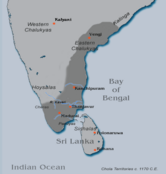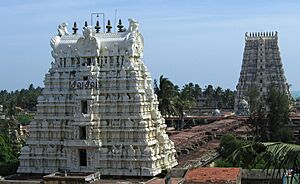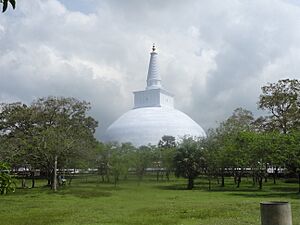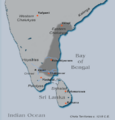Pandyan Civil War (1169–1177) facts for kids
Quick facts for kids Pandyan Civil War |
|||||||||
|---|---|---|---|---|---|---|---|---|---|
 Sinhalese troops ride into Southern India |
|||||||||
|
|||||||||
| Belligerents | |||||||||
|
|
|
||||||||
| Commanders and leaders | |||||||||
|
Kings
Commanders
|
Kings
Commanders
|
||||||||
| Units involved | |||||||||
| Casualties and losses | |||||||||
| Some Tamil soldiers were killed and injured. | Sinhala commanders Lankapura Dandanatha, Jagathth Vijaya and their officers were killed king Parakrama Pandyan I with many number of his soldiers and many number of Sinhalese Soldiers were killed. | ||||||||
| Some Tamils captured from the war were brought to Sri Lanka to renovate the Ruwanwelisaya, Rameshvaram temple plundered by Sinhala army. | |||||||||
The Pandyan Civil War was a big fight that happened in Southern India from 1169 to 1177. It started because two people, Parakrama Pandyan and his nephew Kulasekhara Pandyan, both wanted to be king of the Pandya kingdom. This fight lasted for about 15 years.
Soon, the war grew bigger. The Chola King Rajadhiraja II and the Sinhalese King Parakramabahu I from Polonnaruwa joined in. They each picked a side, hoping to gain more power in the Pandya kingdom.
Around 1169, Kulasekhara attacked Madurai, the capital city. King Parakrama I asked King Parakramabahu I of Polonnaruwa for help. But before help arrived, Parakrama I was killed. Kulasekhara Pandyan then became king. However, Parakrama's son, Vira Pandyan III, teamed up with the Polonnaruwa army. This army was led by General Lankapura Dandanatha. They invaded the Pandyan kingdom, and Kulasekhara Pandyan had to leave.
How the War Started
In 1169, Kulasekhara Pandyan, who wanted to be king, attacked Madurai. The king, Parakrama Pandyan I, asked King Parakramabahu I of Polonnaruwa for military help. But the Polonnaruwa army was too slow.
Parakrama Pandyan's city was taken over. Kulasekhara became King Kulasekhara Pandyan I. King Parakramabahu I then told his general Lankapura Dandanatha to invade Pandya. He wanted him to take Madurai and remove Kulasekhara from power.
Sinhalese Attacks
The attacks began in 1171 or 1172. The Sinhalese army, led by Lankapura, attacked Ramesvaram. After sailing through the Palk strait, Lankapura landed at Ramesvaram. He took treasures from the Rameshvaram temple before setting up defenses.
They set up camp in a place called Kundukala. Lankapura named it Parakramapura, which means "Land of Parakrama" in Pali. Lankapura then learned that Vira III, Parakrama Pandyan's son, was still alive. He decided to join forces with Vira III. Some prisoners taken by Lankapura were sent to help fix the Ruwanwelisaya temple. It had been damaged by the Cholas many years before.
Lankapura defeated local leaders who supported Kulasekhara at Madamdura. He then took control of Patapatha.
Kulasekhara Pandyan fought hard against the invasion. He asked the Chola King Rajadhiraja II for military help. Rajadhiraja sent a strong army led by commander Pallavarayar. The Chola army fought the Polonnaruwa forces in big battles at Kilenilaya and Ponnamaravathi. Kulasekhara also asked for help from some Kongu leaders. They helped him gather more soldiers. The army led by Lankapura moved towards Madurai. They broke through the Chola defenses. Kulasekhara quickly left Madurai, and Vira Pandya was made king.
Chola Attacks
King Rajadhiraja II then sent his commander, Thiruchitrambalamudaiyan Perumanambi. He gave him clear orders: kill Lankapura and Jagad Vijaya of the Polonnaruwa army. He also told him to hang their heads at the gates of the Madurai palace.
The commander, Pallavarayar, helped Kulasekhara. He brought his army and took back the Pandyan kingdom. He followed the king's orders exactly. He hung the heads of Lankapura and other soldiers at the gates of Madurai.
Chola records say that the Chola army helped a lot. Their help made the Ceylonese army leave. After the Ceylonese left, Kulasekhara kept fighting. It seems he eventually won. The war against Vira Pandya continued even after the Sinhalese left. Kulasekhara died during the war or soon after.
The last great Chola king, Kulottunga III, continued the fight for Kulasekhara's son, Vikrama Pandya. A Chola record from 1182 says that the Sinhalese soldiers ran into the sea. Vira Pandya himself had to retreat. The city of Madurai was captured and given to Vikrama Pandya. The war ended in favor of the Cholas around the 1170s.
There were rumors that Parakramabahu was getting ready for another invasion. So, Rajadhiraja II sent a group of soldiers led by Annan Pallavarayan. They attacked Polonnaruwa first. Annan Pallavarayan stopped Parakramabahu's plans for invasion. The Cholas also helped Sri Vallabha, a Sinhalese prince. He was Parakramabahu's nephew and also wanted to be king of Polonnaruwa. Sri Vallabha stayed with the Chola army and helped them.
The Chola army, with Srivallabha, captured and destroyed many places in Ceylon. This included Pulaiccēri and Mātōţţam, where Parākramabāhu was gathering his forces. They took many elephants and burned a large area. They killed some Sinhalese leaders and captured others. Annan Pallavarāyan gave all the captured treasures to the Chola king. This stopped the Ceylonese ruler's plans.
Some historians say that Parakramabahu changed his mind. He sent expensive gifts to Kulasekhara, asking him to attack the Chola Kingdom. Kulasekhara did attack the Cholas but was defeated. Chola forces then invaded the Pandya kingdom. They put Prince Vira Pandya back on the throne. However, other historians say Kulasekhara died during the war. His son, Vickrama Pandya, kept fighting against the Chola forces.
After the War
Vira Pandya remained under Chola control for a while. But he later wanted the Pandya country to be independent. He started fighting the Cholas when Kulasekhara's son, Vickrama, was also fighting him. Even with help from Parakramabahu, Vira Pandya was defeated. Vickrama then became king. The armies of Parakramabahu controlled Rameshwaram until 1182.
Images for kids
-
Chola Territory before the war.
-
Chola Territory after the war.
See also
- Parakrama Pandyan II
- Chola conquest of Anuradhapura
- Anuradhapura invasion of Pandya
- Parakramabahu I § War with Bagan







